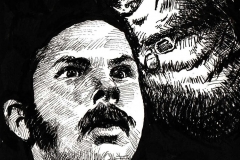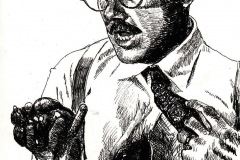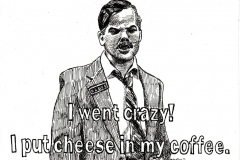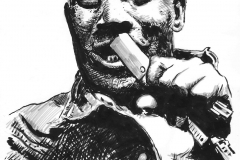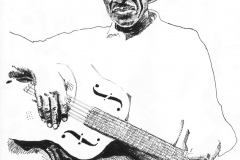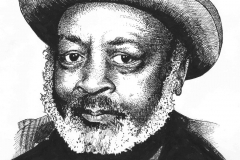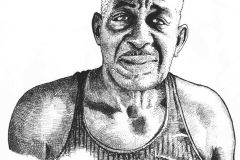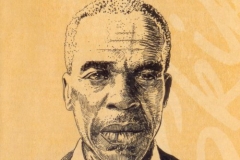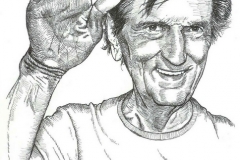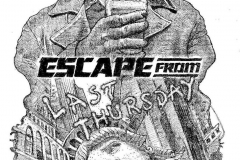An Interview with Matthew Nicely
 by Benjamin Davis Brockman
by Benjamin Davis Brockman
December 1, 2012
If you pick up the recent anthologies of Skip James, Freddie King, or J.B. Lenoir distributed by Fuel Label Group, take a moment to appreciate the fine illustration on the cover. In the age of the MP3, we are all less likely to thumb through liner notes or even hold a jewel case. In the last five years, if I’ve purchased a CD, it’s been a gas station retrospective (The 12 Greatest Hits of Conway Twitty I’m not too proud to claim), and the cover art was as much a forgone formality for the distributor as it was to me as an impulse buyer. But even if you download Fuel’s The Very Best of Skip James from iTunes, the keen hand-drawn illustration may be enough to remind you of a time when there was a visceral component to picking up a CD.
Matthew Nicely is a remarkable draftsman who has such character in his ink drawings that even reproduced photographs of old bluesmen are subtly imbued with his signature. As it happens, he is also friend from my youth.
By some miracle, Matthew and I have maintained contact after parting ways during high school, exchanging music with occasional letters and phone calls for nearly 15 years. It is no surprise to me that his artwork has graced the covers of albums—Matthew is the kind of fellow who could spend a whole day roaming a record store. But as it was when I was 15, the ingenuity of his personal work is increasingly interesting to me.
It was only in the last two years that I became aware of any web presence for Matthew—appropriately it was by a chance Kids in the Hall kick, a show we both had a strong connection to as teenagers. Upon Googling “Bruce McCullough,” I came across Matthew’s blog post 19 Drawings of Bruce McCullough.I was blown away, and immediately posted the images to the Official Kids in the Hall Fan Page. To this day, I’m unsure if Brucio has seen those drawings, but I’d love to know that I was the reason he did!
While the drawings could grace the walls of a gallery, it seems clear that they weren’t really intended for the snobbery of typical art crowds. In fact, in perusing Matthew’s blog, some of his work doesn’t even seem intended for display. The drawings are like entries in a personal sketchbook, like the intimate pieces I remember him creating in junior high school. The work is stunning, funny, somehow both simple and ornate, but the artist himself and his creative practice have always been truly striking. More recent blog posts include commissions, illustrations and work based on practical purpose, but the unique hand of the artist is present in each. After wrestling with the ethical dilemma of covering someone about whom my sentiment was so clearly an issue, I contacted my old friend for an interview.
The Fiddleback: How did you become involved with Fuel Label Group?
Matthew Nicely: I received an e-mail from Len Fico, the president of the label, that said he was interested in licensing a drawing I had done of Skip James that he found on my blog. I’ve never asked him, but I assume he just Googled “Skip James Illustration” or something, and somehow found me. That’s sort of the idea for my blog, which is really just an online portfolio, but it’s really the first time anybody contacted me out of the blue like that. He called me a few months later asking if I had any drawings of J.B. Lenoir or Freddie King. He said he needed them “yesterday.” I got them to him in a day or two.
I’ve done drawings for six covers so far. Mostly blues artists. I really like blues—some blues—but I never guessed that that would be the sort of thing I would get paid for. R. Crumb already did that stuff and did it much better, but it’s a great opportunity.
The last one I did was of Freddie Fender, so I guess I’ve moved on from blues to Hispanic country singers.
 The Fiddleback: You seem to have an interest in pop culture, or more specifically, certain figures in pop history. For instance, I remember you talking about Montgomery Clift a lot, and how his story was particularly interesting to you. Do you gravitate towards stories of troubled lives? Does the biographical side of performers interest you in a broad way?
The Fiddleback: You seem to have an interest in pop culture, or more specifically, certain figures in pop history. For instance, I remember you talking about Montgomery Clift a lot, and how his story was particularly interesting to you. Do you gravitate towards stories of troubled lives? Does the biographical side of performers interest you in a broad way?
MN: I am interested in the lives of artists whose work I admire, which is something that just about anybody could say. If I see a movie or listen to a record, I want to read about it, the people involved, to put it into context. I have always really liked old movies, not necessarily a particular era or genre, but especially classic Hollywood movies. Everybody looks better in black and white. I find it easier to romanticize all those dead people. I’d feel silly drawing pictures of George Clooney.
As for being interested in troubled lives, sure, who isn’t? I started reading Mel Blanc’s autobiography years ago because I love all those Warner Bros. Cartoons, and he did the voices for every one of those characters. But I never finished the book. He was a nice guy who worked hard and lived happily. Not enough trouble. Montgomery Clift was very troubled, but it wouldn’t matter if he weren’t a great actor. It’s a shame about Ian Curtis, but Joy Division never made a bad record. That might be a bit of a tangent.
I’m drawn to narrative in everything; visual art’s no exception. This is related to me being a writer, a lapsed writer at the moment. There is always a story there. I have difficulty with art that I can’t connect with a story. I spend a lot more time reading comics than staring at paintings.
The Fiddleback: As long as I’ve known you, music has always been at the core of our friendship. Does that interest cross over into your creative practice (in ways which aren’t readily obvious?)
MN: I’m a little obsessive with music. I have no capacity to make it, which will always be a regret. I work at a record store. I compulsively buy music beyond my means. It would be nice if I could justify that by saying that music is essential to my creative process. That sounds pretty good. Music is essential to my creative process.
I’ve always listened to music while I work, even if I’m in a bar or a coffee shop where I don’t get to pick what I’m listening to. I couldn’t say that what I’m listening to affects what I draw in most cases. Folk crosshatching looks a lot like metal crosshatching. Maybe my lines are sloppier when I’m listening to jazz. I should really do some research.
The Fiddleback: For a long time, you were working in theater along with writing and drawing. Is that interest ongoing? What are you working on now?
MN: I wouldn’t say that I have no further interest in writing for theater, but there is nothing on the horizon. I wrote plays for a theater company because I had friends who were involved and it was a way for me to find use for my writing. I don’t have much patience for theater, as I know it, and I don’t have any current connections to that world, so there is nothing foreseeable. It was nice to have something that I made taken to its intended conclusion. I’ve never had any luck getting my work published, so plays were gratifying to me in that they were preformed.
Writing is important to me. Maybe more so than drawing. The difference is, I can convince myself that people want and have use for my skills as an illustrator, so the writing has taken a back seat. I have every intention of picking it back up, but I am embarrassingly rusty.
The Fiddleback: How did the Bruce McCullough series come about?
MN: I had a group show scheduled with my friends Tony Hix and Rachel Mulder at a bar in Portland called Cruzroom. We sat over drinks trying to come up with some theme, and after hashing out the usual esoteric concepts, Rachel threw out the fact that we were all enamored with The Kids in the Hall, and Bruce McCullough in particular. He became the obvious mascot.
I encourage everybody to look at Tony and Rachel’s work. Neither of them had quite as literal read on the subject as I had, but the project was a lot more interesting than building a show around something as intangible as “loneliness” or “identity” or whatever. And if, for whatever reason, you are unfamiliar with Brucio, check him out. He is a very, very funny man.
The Fiddleback: Are you aware if Bruce has seen the drawings?
MN: I was contacted by a magazine in Canada who was running an article on Bruce who wanted to use one of my drawings. I said “yes” if they would pass my work onto him. I never heard back.
If I could go back and talk to my younger self I would ruin everything. I’m so glad I didn’t know then what I know now. I made it out of those horrible towns and am much happier now, but if I was happy when I was a teenager I think it would have done me in.
The Fiddleback: Does pen and ink have a certain allure in your creative practice? You seem to have such a command of it, and it mostly dominates the work I’ve seen of late.
MN: Pen and ink is what I’ve spent the most time working with and is what I am the best at as a consequence, probably, rather than having dedicated myself to ink because I had a knack for it. Or it seems that way, anyway.
I’ve always felt that I had more business making things that can be easily reproduced and distributed than in creating singular art objects to be sold in galleries. I’ve always found the capital “A” Art world intimidating. Other than from friends, I’ve never bought paintings, but I’ve bought a lot of comic books. I have a great appreciation for people who can paint or sculpt or make a really good instillation, but I’d also like to be able to have the thing bound up, on paper, in the same way that I have some good memories of having attended rock shows, but mostly I’d rather just listen to the band’s record.
Another, truer answer is that I’m more comfortable working with pen and ink. You are limited but the limitations work for you, and you can take it anywhere. My dad and my stepmom are visiting right now, but if they weren’t I’d probably be at a bar working on my current commission, which is a portrait of a mentally handicapped fella, surrounded by onion rings. He loves onion rings, this guy. I’m fond of them, myself.
The Fiddleback: Is there anything you’d like to try that you haven’t as far as art is concerned?
MN: I’d like to learn to paint rather than drawing with paint. I feel like I shouldn’t be so scared of color. Also, I’d like to make comics, which is something I’ve always wanted to do, but it’s daunting. I’ve done several small things, but I really want to make some sort of massive graphic novel that would destroy me, if only I had a good story. I don’t want it to feel like I’m treading stylistic water just doing crosshatched black-and-white portraiture, although if people like it and some of those people want to pay me to do it, I’ll probably keep crosshatching.
The Fiddleback: What are some of the best records you discovered in 2012? Films? Books?
MN: It is a requirement where I work to come up with a list of my top ten records of the year, which I begrudgingly complied with. For what it’s worth, here is what I put down, even though the year isn’t over and I never find the best record of any given year or decade until much later:
Swans – The Seer
Pallbearer – Sorrow & Extinction
Fiona Apple – The Idler Wheel…
Horseback – Half-Life
Godspeed You! Black Emperor – Allelujah! Don’t Bend! Ascend!
The Weeknd – Trilogy
Lambchop – Mr. M
Killer Mike – R.A.P. Music
Chromatics – Kill For Love
Scott Walker – Bish Bosh
I haven’t even heard the Scott Walker album yet because it wasn’t released, so it could be awful. Anyway, what you asked me was records I discovered in 2012, so I picked up some great records by Iron Maiden, Roger Miller, Ben Frost, Unwound, Sleepy John Estes, Val Stoeklein, and an incredible compilation of Pakistani film music on the Finders Keepers label called Life is Dance. There have been some great L.P. reissues this year for Aphex Twin, Sparklehorse, Tsege Mariam Gebru, Codeine and a bunch of other stuff I’m not caught up on.
I haven’t seen too many new movies. I was able to go to Seattle and watch The Master on 70 mm. That was pretty spectacular. Video-wise the stuff that blew me away was Curse of the Cat People, which I might have watched last year, but it’s flat-out beautiful, and everyone should watch it and Miami Blues, which I remembered being good, but I was wrong: It’s amazing. Unfortunately, I forgot how to read, so I can’t weigh in on books. I did pick up the massive new Chris Ware book(s), Building Stories, which I’m chipping away at. It’s lovely and depressing and frustrating, just as I suspected.
The Fiddleback: Do you think there was any part of your upbringing that led to your interest in drawing or making? My earliest memories of you from junior high include the drawings in your sketchbooks and the immaculate logo reproductions you did for mix and dub tapes. Our interests at that age were enough to make us black sheep in small-town America. Do you see any through line to your creative trajectory?
MN: Even if you weren’t ostracized, the so-called artistic temperament tends make you feel like a pariah, or at least keep most people at arms’ length. The feelings of otherness and alienation were as essential as practice or whatever innate skill I had in drawing when I was at that age. I was an idiot and I drew lousy pictures, but I wasn’t wrong, necessarily. If I could go back and talk to my younger self I would ruin everything. I’m so glad I didn’t know then what I know now. If I knew then what I know now, I might have given up altogether. I’d be more boring than I am now. I made it out of those horrible towns and am much happier now, but if I was happy when I was a teenager I think it would have done me in.
I like when things are funny and sad. I like when there is story and the story isn’t over-told. I hate disingenuous laughter and tube tops. There may be a larger through line than that but I don’t know what it is.
The Fiddleback: I’m asking this question of everyone I interview, but I’m particularly interested in your take. Why do you think art is important? To frame it a certain way: When a dentist tells someone he is a dentist, he seldom has to explain himself. Why is it that artists so frequently have to make a case for the value of the arts? What is that case, in your opinion?
MN: I feel like I used to have more grandiose answers to that question. My faith in the significance and redemptive value of the arts hasn’t lessened, but my ambitions within those beliefs have become more modest and compartmentalized. Temporarily. I hope.
Nearly everything I care about and absolutely everything I aspire to falls under the rubric of “The Arts.” Music, film, books, napkin scribbles, jokes, conversation, cooking—that’s all art, isn’t it? I read an interview with someone, I can’t remember who, an activist, a champion of human rights, someone who was passionate about his ideas about how we can take care of everyone and everything on the planet and the planet itself if we stop being so greedy. When asked about funding for the arts, he quite pragmatically said something to the effect that the arts were well and good, but first we should sort out how to feed our poor and keep our diseased planet from eating itself. Or to follow the tangent a little further: Bill Hicks, discouraging procreation, “Let’s figure out this food/air deal.” I am spoiled and short-sided and am regretful of those facts, but art is the most important thing to me. I am certain I would feel different if I were starving.
